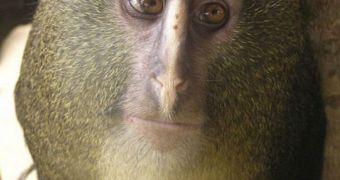A team of scientists and conservationists from the Lukuru Wildlife Research Foundation, in the Democratic Republic of the Congo (DRC), announces the discovery of a new species of African monkey, called Cercopithecus lomamiensis.
The creature was found in the central parts of the DRC. C. lomamiensis is only the second species of monkey to be discovered in nearly 30 years, a fact suggesting that researchers have most likely discovered most of the living species of monkey nature has to offer.
The other species to be discovered in recent times was the ‘honk barking’ Highland mangabey (Lophocebus kipunji), which was found in Tanzania. Details of the new species appear in this week's issue of the esteemed open-access, peer-reviewed journal PLoS One.
LWRF conservation biologist John Hart led the team of experts that found the monkey. The first exemplary was acquired in 2007, and was a young pet female. Apparently, the locals had a good knowledge of the species, which they called Lesula.
The monkey was found in the home of a primary school director in the town of Opala, DRC. “He reported that he acquired the infant about two months earlier from a family member who had killed its mother in the forest near Yawende, south of Opala and west of the Lomami River,” the team said.
“We took photographs of the animal and made arrangements for its care. We observed and photographed this animal regularly over the next 18 months,” the research group goes on to say.
After recovering a little bit of skin from a specimen killed by hunters, Hart and his group sent it for analysis to genetics experts at the New York University, and also the morphologists with the Peabody Museum, at the Yale University.
It took all these scientists more than three years to complete their full analysis of the data.
“Our conclusion: This is a new species of monkey. Its home is the TL2 Landscape, west of the Lomami River [hence its scientific name]. It is separated by two major rivers from its closest relative, the owl-faced monkey” (Cercopithecus hamlyni), says Therese Hart, John's wife, and a member of the team.
She explains that the reason why this species has not been detected before is that the forests it occupies are largely wild, and difficult to get to, Scientific American reports.

 14 DAY TRIAL //
14 DAY TRIAL //